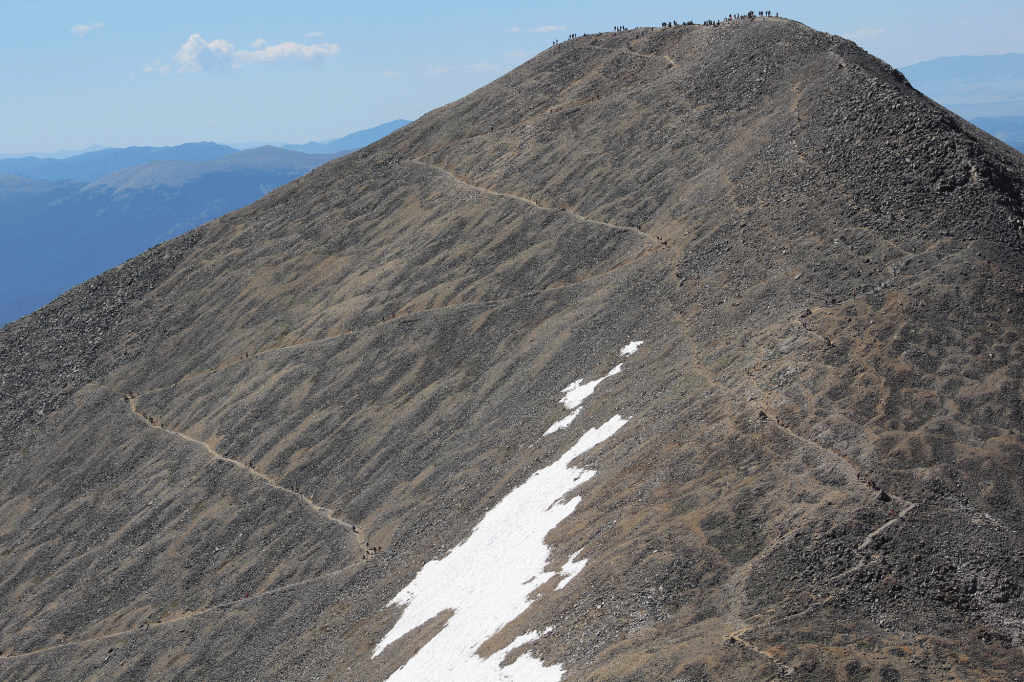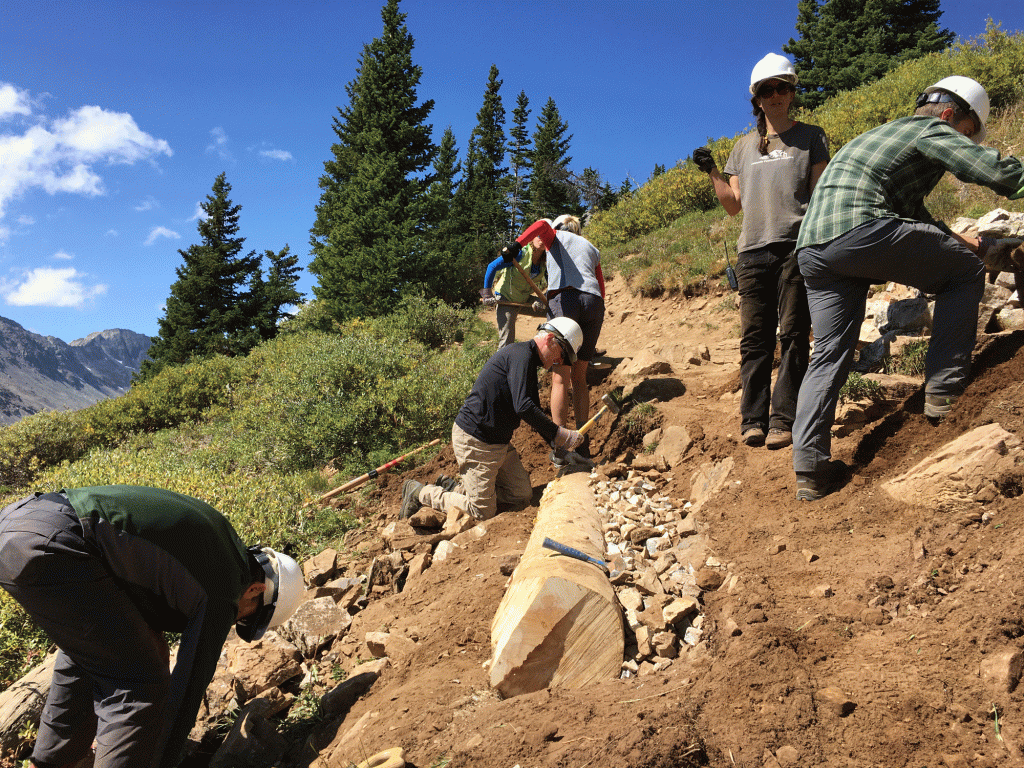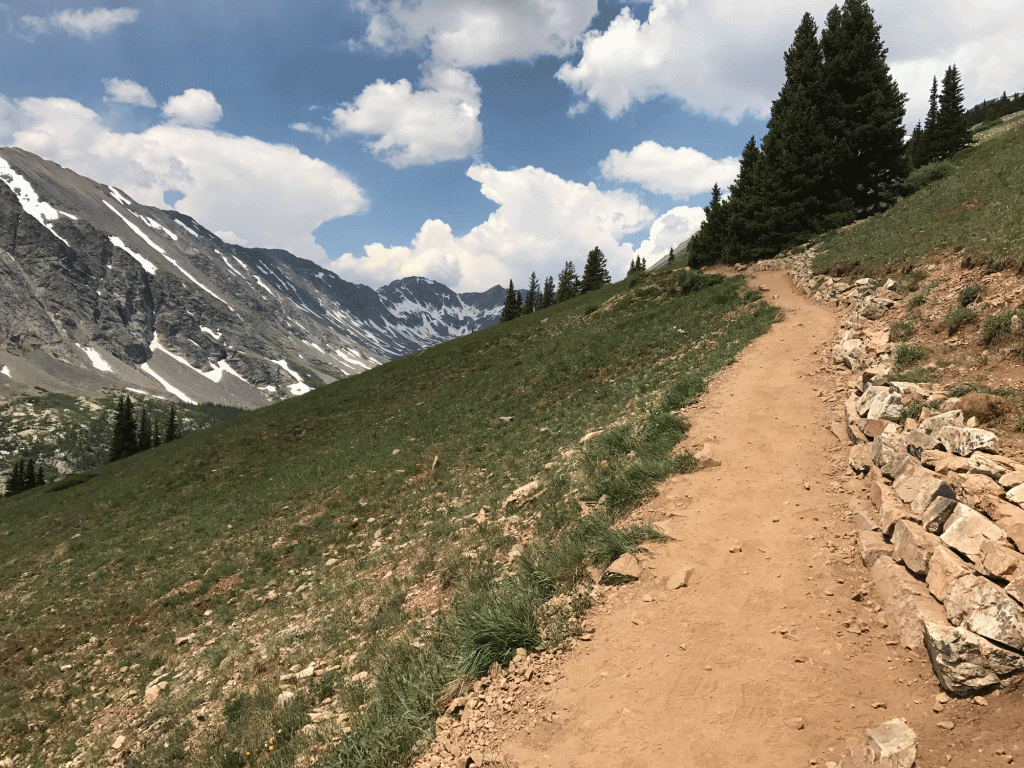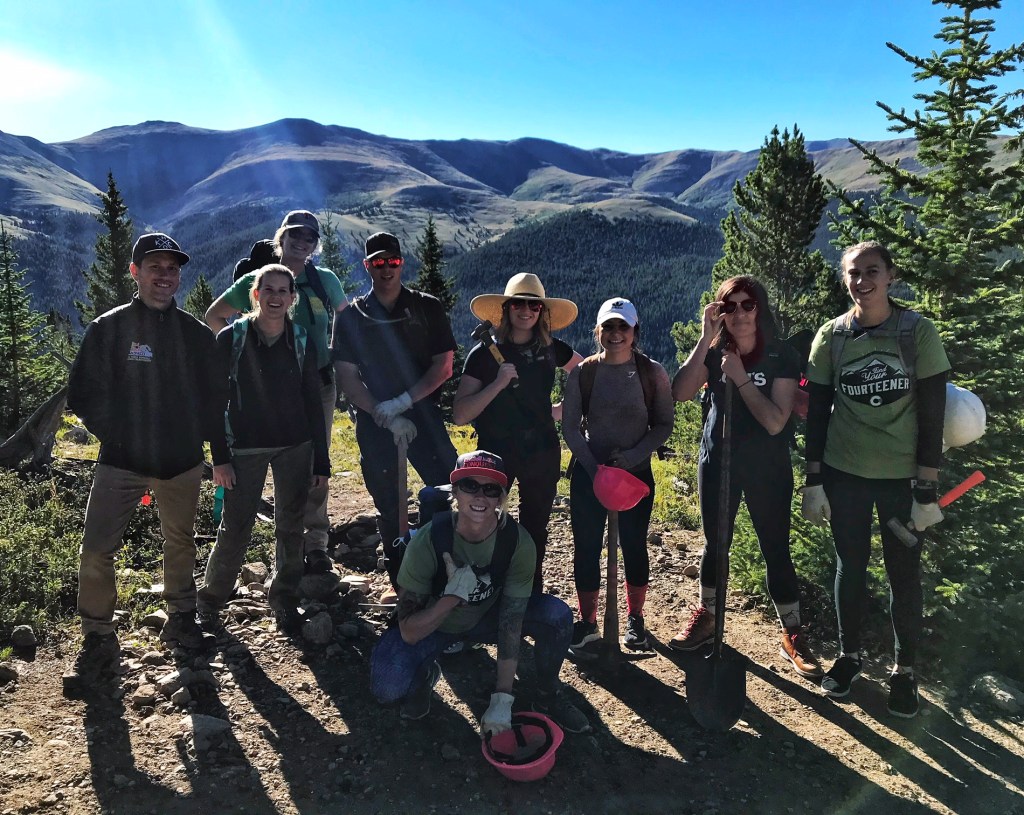Like many Coloradans, Ben Hanus was on a mission to bag some fourteeners. Unlike many Coloradans, his incentive to summit the 14,000-foot peaks wasn’t personal; it was about preservation.
From 2011 to 2013, Hanus served as the sustainable trails coordinator for the Colorado Fourteeners Initiative (CFI), a role that led him up 42 of the state’s highest peaks to collect data about the condition of the routes leading to their summits. In 2015, his efforts caused the nonprofit to develop the state’s first-ever Fourteener Report Card, giving interested parties—land managers, policy makers, stewardship groups and recreationists—insight into what it would take to protect the peaks for decades to come.
In the past fifteen years, Colorado’s population has grown by approximately two million. The CFI estimates that at least 334,000 people now hike the trails that lead to the top of Colorado’s more than 50 fourteeners, or peaks higher than 14,000 feet, each year. Though the data has some concerned that the fourteeners are being loved to death, the Colorado Fourteeners Initiative believes they can use the report cards, and the awareness they’ve raised, to help offset that use.
Bad Grades
Back in 2011, when Hanus was just beginning to inventory the fourteeners, only 27 of the 42 mountains surveyed had planned, constructed routes leading to the summit. The other 16 were considered “unplanned,” meaning that the trails, though heavily trodden, were likely created by years of recreationists hiking the fourteeners, rather than by officials of the U.S. Forest Service or another stewardship group.
Hanus set about evaluating each summit trail based on its features (including retaining walls, staircases, drainage systems) and issues (like erosion, trail widening). Then, he rated the condition of each route’s features and issues and noted what action was required.
At the end of his data collection, Hanus assigned a letter grade and a dollar sign to each route, reflecting what it would cost to bring the route to ideal conditions. CFI compiled this information into the Fourteener Report Card and the numbers were immediately clear: While the peaks with planned, constructed summit trails were holding up better than the fourteeners without, there was a lot of work to be done ($6 million worth of work for the trails with planned, constructed routes, and $18 million for the trails with unplanned trails to the top).

A view of the long ascent up Grays Peak (14,278 feet) with a line of hikers at the summit. The route to the top of Grays and Torreys Peaks it the second-most visited summit trail in Colorado. (Photo Credit: Robert Cole)
The Colorado Fourteeners Initiative loaded the report card with suggestions and recommendations on how to get each trail in shape, how long it would take, and how much each project would cost. The information has been critical: Since 2015, the nonprofit has used this data to plan for each new season of work and apply for the grants and funding that make it possible.
Brian Sargeant, CFI’s development and communication coordinator, says, luckily, the nonprofit isn’t tasked with restoring the fourteener routes on its own.
“Partnership is a huge part of what we do,” he said. “Other organizations recruit volunteers to help with our projects. We know what work needs to be done and where it needs to be done.”
Helping Hands
Having the data helps. In 2017, inspired by the Fourteener Report Card, the National Forest Foundation (NFF) launched its Find Your Fourteener campaign, a collaborative initiative to restore and improve vulnerable fourteener trails using information from CFI, as well as data collected by its governmental partner, the U.S. Forest Service (USFS).
Emily Olsen, the NFF’s Colorado program manager, said that when she became involved in the campaign, the fourteeners were being loved to death, at a rate from which they might never recover.
“The impacts to trails and fragile high-alpine ecosystems have outpaced the Forest Service and existing partners’ abilities to address the endless conservation needs with a ‘business as usual’ approach,” she said. “The Find Your Fourteener campaign goal is to increase the pace and scale of improvements to sustainable recreation opportunities on Colorado’s fourteeners on national forest lands.”
Take Quandary Peak, for instance. Located less than 10 miles from the town of Breckenridge, Quandary is the first fourteener many recreationists summit. But its popularity had taken a toll: Quandary received a C+ on the 2015 report card, with an estimated $500,000 to $999,999 needed to bring the route to ideal conditions.

Volunteers help prevent erosion on Quandary Peak. In 2015, the Colorado Fourteeners Initiative estimated it would take between $500,000 and $999,999 to restore the summit route. (Photo Courtesy: National Forest Foundation)
So in 2017, the NFF quickly turned its attention to Quandary, sending volunteers and trail crews to restore the delicate high-alpine habitat and build sustainable trails. REI contributed to the project, donating $50,000 to the National Forest Foundation to go directly to the restoration work. To complete the work, the NFF partnered with stewardship groups in the region, including CFI and the Rocky Mountain Youth Corps.
According to Olsen, this collaborative approach is directly in line with the objectives of the Find Your Fourteener campaign. “From the beginning, we identified bottlenecks that can get in the way of work on fourteeners and have explored collaborative and novel approaches,” she said.
Nevertheless, traffic to the popular fourteener summit continued to spike. In 2017, the CFI estimated that approximately 20,000 to 25,000 hikers trudged up the peak. So the NFF and its partner organizations, including REI, doubled down, devoting a two-person CFI crew and a total of 282 volunteers who improved 1.75 miles of trail and restored one-tenth of an acre of habitat in 2018. To date, REI, has donated a total of $528,000 to the Find Your Fourteener program thanks to REI Co-op Mastercard cardholders. The program supports the protection and restoration of fourteener trails like those leading to the top of Quandary Peak throughout the state. This year, REI plans to donate another $133,000 to the effort.

A wall constructed to delineate the Quandary Peak Trail, prevent erosion and keep alpine areas intact. (Photo Courtesy: National Forest Foundation)
When restoring trails, volunteers and trail crews engage with hikers pausing to catch their breath or devour a handful of trail mix—and this has an added benefit. According to the 2018 REI/National Forest Foundation partnership year-end report, volunteers and trail crew members involved with the Quandary Peak project educated more than 16,300 hikers about responsible and sustainable recreation that year.
This June, the NFF, CFI, Friends of the Dillon Ranger District and other partners are hosting a hike up Quandary for anyone who was involved in the three-year improvement. The cause for celebration is obvious, but it’s also because of Quandary’s performance on this year’s new report card: The peak’s grade leapt up to an A.
A New Year, A New Report Card
During the 2017 and 2018 seasons, the Colorado Fourteeners Initiative re-inventoried 17 of the fourteener routes and collected baseline data on 22 additional ones. This summer, the nonprofit plans to release a second Fourteener Report Card to show what’s changed since 2015.
Sargeant said this information will help determine where the organization will focus its efforts moving forward. The new data also reveal that, even with increasing visitor numbers, the fate of the fourteeners isn’t as dire as some predicted.
“We’ve noticed from the data we’ve been collecting,” Sargeant said, “that if we have a sustainable route with annual maintenance and well-built structures, the trails can handle the traffic.”
In the future, the National Forest Foundation plans to increase the scale of its trail improvements on Colorado’s high peaks. This year, they’re expanding the Find Your Fourteener campaign to include new projects, including a three-year effort to restore the Grays Peak National Recreation Trail, which accesses Grays and Torreys Peaks, near Denver.

A group of volunteers on the Quandary Peak Trail, where 282 volunteers improved 1.75 miles of trail and restored one-tenth of an acre of habitat in 2018. (Photo Courtesy: National Forest Foundation)
Each year, the trail leading to the top of these two fourteeners sees 25,000 to 30,000 hikers, making it the second-most visited summit trail in the state. Grays and Torreys received a C+ on the 2015 CFI report card, mostly due to trail widening and erosion. Data from the CFI suggests some 60,000 to 100,000 hikers have accessed the two fourteeners since 2015, so it’s no wonder Grays and Torreys earned a depressing F on this year’s progress report.
Beginning this year, volunteers and trail crews funded by the National Forest Foundation, REI and other partners will dedicate themselves to reconstructing trails to alleviate degradation associated with the trail braiding, erosion and extensive resource damage occurring above 13,000 feet.
But that’s not the only way REI has had an impact on the peaks. For a month this spring, Sargeant said, REI customers who made a purchase in-store were given a token at the register as part of the co-op’s Loving Our Local Outdoors initiative. Customers were able to choose from three local stewardship projects that got funding based on the number of tokens allocated. CFI was one of the beneficiaries in the Denver-based stores.
“In fact,” he said, “REI is almost exclusively funding the Grays and Torreys project. From the NFF Find Your Fourteener funding to the tokens to grants from local REI stores.”
According to some, there’s a silver lining to all the attention the fourteeners draw.
“It’s a good problem to have,” said Joe Lavorini, the program director at the Rocky Mountain Field Institute. “The more time people spend outside, interacting with the natural environment, the better.” With the increase in use, however, comes an increased responsibility for recreationists to tread lightly.
“It’s hard not to love these places,” said Olsen. “However, across the state, we’re developing action-oriented partnerships and leading collaborative efforts that help address the over-loved nature of these places by connecting people and communities to their public lands.”
____________________________________________________________________________
*This year, REI will donate $0.10 per REI Co-op Mastercard purchase transaction made to the National Forest Foundation, up to $1 million. Non-Purchase transactions, including cash advances, convenience checks, balance transfers, and other advance transactions as defined in the Cardmember Agreement, as well as interest charges and fees, do not qualify. Transactions posted in late December of the current year may be applied in the following year. REI may change the benefit or named charity in future years. REI is solely responsible for making the donation.
The creditor and issuer of the REI Co-op Mastercard® is U.S. Bank National Association, pursuant to a license from Mastercard International Incorporated.
© 2019 U.S. Bank
© 2019 Recreational Equipment Incorporated. All rights reserved.


